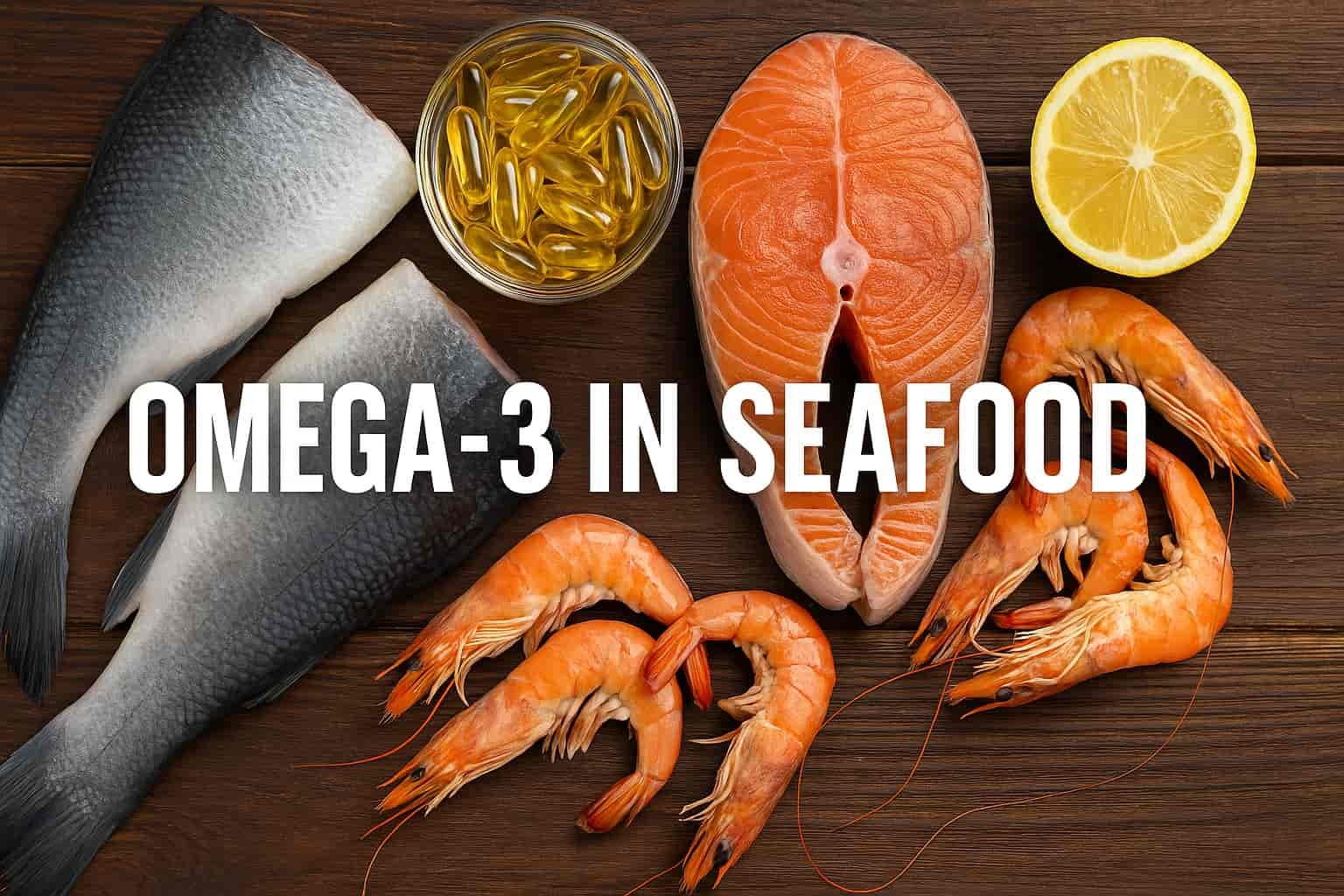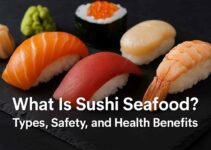Omega-3 fatty acids are essential nutrients that the human body cannot produce naturally. These critical fats play a direct role in maintaining cardiovascular health, supporting brain function, and reducing chronic inflammation. While plant-based foods provide ALA (Alpha-Linolenic Acid), only seafood delivers the highly bioavailable forms of Omega-3: EPA (Eicosapentaenoic Acid) and DHA (Docosahexaenoic Acid).
According to the World Health Organization, adults should consume at least 250–500 mg of combined EPA and DHA daily to achieve optimal health benefits. Relying solely on plant sources like flaxseeds or chia seeds will not fulfill this requirement efficiently, as the human body converts less than 5% of ALA into usable EPA and DHA.
This article provides precise answers to the most frequently searched questions: Which seafood contains the most Omega-3? How much should you eat weekly? And what health benefits are scientifically proven? Each section is designed to deliver direct, fact-based answers without speculation.
Contents
- 1 What Are Omega-3 Fatty Acids and Why Are They Essential for Health?
- 2 Which Seafood Contains the Highest Levels of Omega-3 Fatty Acids?
- 3 How Much Omega-3 from Seafood Should You Consume Weekly for Optimal Health?
- 4 What Are the Proven Health Benefits of Omega-3 from Seafood?
- 5 Are There Any Risks Associated with Consuming Omega-3 from Seafood?
- 6 Which Cooking Methods Preserve the Most Omega-3 in Seafood?
- 7 Who Should Prioritize Omega-3 Intake from Seafood?
What Are Omega-3 Fatty Acids and Why Are They Essential for Health?
Omega-3 fatty acids are essential polyunsaturated fats that support heart, brain, and cellular health. These fats are categorized into three main types:
- EPA (Eicosapentaenoic Acid): Found primarily in fatty fish, EPA is known for reducing inflammation and supporting heart health.
- DHA (Docosahexaenoic Acid): Also abundant in seafood, DHA is critical for brain development and cognitive function.
- ALA (Alpha-Linolenic Acid): Found in plant sources, but less effective because only 0.5% to 5% converts into EPA and DHA.
Why Are EPA and DHA Superior to ALA? EPA and DHA are directly utilized by the human body without the need for conversion. Scientific studies confirm that populations consuming high amounts of EPA and DHA, such as the Japanese, exhibit significantly lower rates of heart disease and cognitive decline.
Which Seafood Contains the Highest Levels of Omega-3 Fatty Acids?
Fatty fish like salmon, mackerel, and sardines contain the highest concentrations of Omega-3. Below are precise Omega-3 values based on USDA data:
- Atlantic Salmon (Wild): 2,260 mg per 100g serving.
- Mackerel: 4,580 mg per 100g serving.
- Sardines (Canned in Oil): 2,200 mg per 100g serving.
Are Shellfish Like Oysters and Mussels Good Sources of Omega-3? Yes, though lower than fatty fish, oysters provide 672 mg and mussels offer 665 mg of Omega-3 per 100g. These are excellent alternatives for individuals who prefer shellfish over fish.
Does Farmed or Wild-Caught Seafood Have More Omega-3? Wild-caught seafood consistently contains higher levels of Omega-3. For example, wild salmon has approximately 33% more EPA and DHA compared to farmed salmon. This difference results from the natural diet of wild fish, which includes Omega-3-rich marine algae.
How Much Omega-3 from Seafood Should You Consume Weekly for Optimal Health?
Adults should consume at least two servings (totaling 300–500 grams) of fatty fish per week to meet the recommended Omega-3 intake.
What Do Leading Health Organizations Recommend for Omega-3 Intake?
- World Health Organization (WHO): 250–500 mg EPA and DHA daily.
- American Heart Association (AHA): At least two servings of fatty fish per week.
- European Food Safety Authority (EFSA): Up to 5,000 mg per day is considered safe for long-term consumption.
How Does Omega-3 from Seafood Compare to Supplements? Omega-3 from seafood provides superior bioavailability. A study published in the Journal of Lipid Research confirms that Omega-3 from fish is up to 50% more bioavailable than soft gel supplements. Additionally, consuming seafood delivers other essential nutrients such as vitamin D, selenium, and high-quality protein, which supplements lack.
What Are the Proven Health Benefits of Omega-3 from Seafood?
Omega-3 from seafood provides 5 scientifically proven health benefits: cardiovascular support, cognitive enhancement, anti-inflammatory effects, improved eye health, and joint pain reduction.
How Does Omega-3 Improve Cardiovascular Health? (With Specific Data) Consuming Omega-3 from seafood reduces the risk of heart disease by 25%, as confirmed by a 2021 meta-analysis published in Circulation. EPA and DHA lower triglyceride levels by up to 30% and reduce blood pressure by an average of 5 mmHg in hypertensive patients.
What Is the Role of Omega-3 in Brain and Cognitive Function? DHA accounts for 40% of the brain’s polyunsaturated fatty acids, making it critical for cognitive health. Studies show that individuals consuming at least 1,000 mg of DHA daily demonstrate a 15% lower risk of Alzheimer’s disease. You can learn more by visiting our article on seafood nutrition facts.
Can Omega-3 from Seafood Help Reduce Inflammation and Joint Pain? EPA acts as a natural anti-inflammatory agent. Consuming 2,000 mg of EPA daily reduces C-reactive protein (CRP) levels—a key marker of inflammation—by 20%. This results in measurable pain relief for people suffering from rheumatoid arthritis and joint stiffness.
Is Omega-3 Beneficial for Eye Health and Vision Protection? DHA constitutes 93% of the Omega-3 content in the retina. Consuming 500–1,000 mg of DHA per day reduces the risk of age-related macular degeneration (AMD) by up to 38%, as reported by the Age-Related Eye Disease Study (AREDS).
Are There Any Risks Associated with Consuming Omega-3 from Seafood?
Omega-3 from seafood is safe when sourced properly, but consuming contaminated seafood increases exposure to mercury, polychlorinated biphenyls (PCBs), and dioxins.
Can Heavy Metals or Contaminants in Seafood Impact Omega-3 Benefits? Yes, contaminated seafood can offset the benefits of Omega-3 by introducing harmful toxins into the body. The FDA reports that large predatory fish like shark, swordfish, king mackerel, and tilefish have the highest mercury levels, exceeding 0.9 ppm.
How to Choose Seafood Sources Safely to Maximize Omega-3 Intake? Select fish certified by organizations like the Marine Stewardship Council (MSC) and the Aquaculture Stewardship Council (ASC). Choose low-mercury, high-Omega-3 options such as:
- Wild Salmon: Mercury content below 0.022 ppm.
- Sardines: Low in mercury and high in Omega-3 with 2,200 mg per 100g.
- Anchovies: High Omega-3 levels at 2,113 mg per 100g, with minimal contaminants.
Which Cooking Methods Preserve the Most Omega-3 in Seafood?
Steaming and baking preserve over 90% of Omega-3 content, while deep-frying reduces Omega-3 levels by up to 70%.
Does Grilling, Baking, or Frying Affect Omega-3 Levels? Grilling and baking retain the majority of Omega-3 if cooking temperatures remain below 190°C (374°F). In contrast, frying at higher temperatures destroys Omega-3 fatty acids and introduces harmful trans fats if unhealthy oils are used.
What Are the Best Recipes to Maximize Omega-3 Retention?
- Steamed Salmon with Lemon and Herbs retains 95% of Omega-3.
- Baked Mackerel with Olive Oil and Garlic preserves over 90% of EPA and DHA.
- Avoid recipes requiring prolonged frying or charring, as Omega-3 degradation increases significantly at high heat.
Who Should Prioritize Omega-3 Intake from Seafood?
Three key groups should prioritize Omega-3 intake from seafood: pregnant women, children, and adults over 50.
Are Pregnant Women and Children Advised to Increase Omega-3 from Seafood? Yes. Pregnant women require at least 300 mg of DHA daily to support fetal brain and eye development. For children, Omega-3 supports cognitive function and behavioral development. A 2018 study published in The American Journal of Clinical Nutrition found that children consuming 600 mg of DHA daily achieved better attention scores and higher reading levels by 10% compared to those with lower intake.
Should Athletes and Older Adults Focus on Omega-3 Consumption? Yes. Athletes benefit from Omega-3 due to its anti-inflammatory effects, which reduce muscle soreness by 25% and improve recovery times. Adults over 50 should focus on Omega-3 to prevent cognitive decline and maintain cardiovascular health. Studies show that seniors who consume at least 1,000 mg of Omega-3 daily reduce the risk of dementia by up to 20%.



